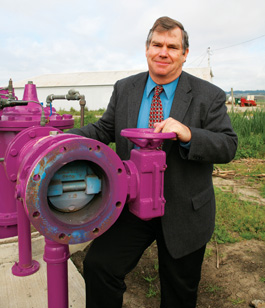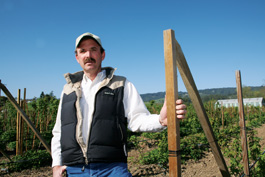home | metro santa cruz index | features | santa cruz | feature story

Photograph by Carlie Statsky
Thankless Task: Former Watsonville Mayor Dennis Osmer stepped up to serve on the board of the water district and is now helping to steer it through the worst crisis in its history.
The Watsonville Water Wars
How the Pajaro Valley Water Management Agency was brought to its knees
By Paul Wagner
Dennis Osmer, former mayor of Watsonville and veteran survivor of more boards and commissions than one can count, has a way with humor.
When he applied to serve on the board of the troubled Pajaro Valley Water Management Agency (PVWMA) in June of 2006, for instance, he wrote only one personal comment: "I agree with Mark Twain ... the two biggest problems we have in the valley are (1) not enough water and (2) flooding. The order changes occasionally."
There is still, nowadays, a chuckle in his voice, but also subtle overtones of stress, when he speaks about his current role as board chairman.
"I agreed to join the board because nothing could be worse than serving on the county Planning Commission," he says.
Little did he know.
Osmer couldn't have known, for instance, that within 2 1/2 years of his joining the water agency, its general manager would leave without a successor, so that Osmer and two other board members would need to serve as a temporary ruling troika.
Nor that long-laid plans to pipe water in from the Central Valley would fall to a federal court decision to protect the tiny Delta smelt last autumn, or that losing that lifeline would scuttle the only existing plan to plump up freshwater valley aquifers and fight saltwater intrusion.
And he certainly couldn't predict that party after party would successfully sue the water agency for imposing fees it had considered legal but courts said were not, ultimately costing the agency $13.5 million in compensation, $3 million in legal fees and significant cuts in staff.
No, these developments were all new. And yet, in hindsight, they merely added to the instability of an agency many in the farm community had considered shaky from its start.
What turned that instability into imminent possible agency collapse was a trio of lawsuits filed by two groups of farmers and a tax activist outraged by a quadrupling of their water fees over several years.
When farmers themselves started shaking the structure, filing three legal actions between 2002 and 2005 claiming that the agency had illegally imposed the ever-growing fees—and winning—they virtually brought down the house.
Free Agency
One of those farmers was the president of Naturipe Berry Growers, Tom Am Rhein. Am Rhein spares the water agency little criticism, either about the fees or its performance since its inception.
In "The PVWMA: Comments on the Life of a Troubled Agency," a presentation he gave to valley farmers just two months ago, Am Rhein claims that the institution was itself born in crisis and flawed from the start.
By the 1950s, saltwater intrusion, which is death to farming, had already made its first appearance in the Pajaro Valley. A 1965 attempt to solve that—a tricounty plan to import water—fell apart, Am Rhein noted, when Santa Cruz County opted out. By 1975 saltwater intrusion in valley wells had grown so severe that the state Department of Water Resources issued a warning notice to shape up or risk losing local oversight.
In 1982 the Santa Cruz County Farm Bureau, sensing a potential county takeover of the valley's water supply, called for public meetings, and a committee of 33 emerged to put together a proposal for a local water agency.
But that, too, went awry. State Sen. Henry Mello, trying to meet legislative deadlines, requested and got an unfinished draft of the proposal. Then-Supervisor Gary Patton lobbied for and won a ban on importing water for nonagricultural purposes so as to limit residential growth, ensuring future ag/housing disputes. And changes no one in the valley had seen or agreed to wormed their way into the agency plan.
The result was a water agency born with more power than many, and discontent over that never subsided. Mary Bannister, a technical division manager who began working for the agency in 1999, recalls that her predecessor told her of board meetings in which attendees would "stand up and start pushing each other" and sessions that "would almost break into fistfights." As saltwater intrusion worsened, the costs of potential solutions rose and fees skyrocketed. Tensions between the agency and farmers—and even between groups of farmers—ratcheted up.
Even Action Pajaro Valley, the can-do, anything-is-achievable stakeholders' planning group, asserted bluntly in its 1999 Strategy Workbook: "It is uniformly agreed that the management of water resources in the Pajaro Valley requires serious professional attention."
Dick Peixoto (pronounced "puh-shoat"), an organic grower long involved in valley water issues, adds another angle to the history of discontent.
"PVWMA, formed back in the early '80s, wanted local control," he remembers, "but after 15 to 20 years, it came up with a Basin Management Plan that depended on a pipeline. And by doing that"—running pipes from the Central Valley to import water, which needs approval of the Department of Water Resources—"you're basically under control of the state."
Peixoto felt so strongly about avoiding state involvement that he formed a group in 1986 called No Overpriced Pipelines Ever (NOPE), which put a measure on the ballot that year delaying any pipeline-based water importation plan for a decade. And it succeeded; voters said yep to NOPE.
But soon after the 10-year moratorium expired, the water agency began pursuing the pipeline project again. That course of action became impractical after the August ruling that halved Central Valley water supplies in order to protect the Sacramento Delta smelt. But to Peixoto, that's a prime example of the agency's historical refusal to listen.
"There is no state water available to us," he says impatiently, "unless we want to go up against Los Angeles."

Photograph by Carlie Statsky
Dry Farming not an Option: Berry grower Tom Am Rhein sued the water district after his water bills quadrupled.
Basin Blues
The workability of the Basin Management Plan is the fundamental determinant of the future of agriculture in the Pajaro Valley. Crops can do without many things—perhaps even daily doses of Mozart—but water isn't one of them.
So an accurate, measurement-centered Basin Management Plan is crucial. And that's what the PVWMA's Mary Bannister presented to the Association of Monterey Bay Area Governments (AMBAG) in 2005. The proposal began with a simple statement:
"The Problem: Need 23,500 AFY."
Translation: the Pajaro Valley, to serve everyone and stop overdrafting, needs 23,500 acre-feet of water per year. One acre-foot is the amount of water required to cover an acre of land in a foot of water; it's about 325,000 gallons, or what three average lawn-loving American families use over a year's time. And the agency needs 23,500 of them to function responsibly. Annually.
"The Solution," continued Bannister's presentation: "Conservation 5,000; Harkins Slough 1,100; Recycled Water Facility 4,000; Import Water Supply 13,400—Total Supply 23,500."
Translation: in 2005, the agency planned to add 5,000 acre-feet a year to the water supply through conservation, obtain 1,100 more by sucking water out of Harkins Slough and add an additional 4,000 by recycling currently unrecycled sewer and wastewater and selling it back to farms for crops-only use.
And it planned to import the rest—13,400 acre-feet a year—from the Central Valley delivery pipeline. The pipeline would be built with funds from the quadrupled water fees.
But since both the pipeline project and the fees to pay for it have evaporated, that 13,400 acre-feet per year—some 57 percent of the 2005 plan's water—has gone missing. So there goes that plan.
As Dennis Osmer says quietly, "The Basin Management Plan is in need of an update."
Zoning Out
In order to update the plan, though, a deeper dispute needs resolution. It concerns the "zone of benefit." That's legal code for who gets what specific benefits from what improvement projects, and therefore will be billed extra amounts for them.
The primary disputants in the payment dustups are coastal farmers—who are seeing such significant saltwater intrusion into their wells that they want immediate action—and inland farmers, who aren't yet seeing the overdrafting effects to nearly the same degree.
And because inland farmers aren't as threatened, notes Farm Bureau president and coastal Brussels sprouts grower Steve Bontadelli, "there's less of a sense of urgency" among them, and they frequently fight against forking over the fees necessary to expand a supply of water they view as primarily benefiting coastal growers. "You're in the zone that gets the most benefit, so you pay," seems a common mantra.
Dave Cavanaugh, who owns a nursery and serves as the Farm Bureau's man on ornamentals, sees this issue as the primary sticking point. "The valley has had problems finding cash for local projects—and we're not going to get that solved until we come up with zones of benefit," he says.
Dennis Osmer agrees. "It's in the zones of benefit," he says, that "we have to find more common ground."
Part of the trouble in mapping out zones of benefit has come from suspicions on the part of some inland farmers and observers that the high water content of newer berry crops means that they're hogging more than their share of water.
Berry growers, including Tom Am Rhein, say it's not so. For one thing, he says, almost every crop now grown in Pajaro Valley is thirstier than the orchards that once carpeted the area.
"All things being equal, vegetables, strawberries or raspberries use more water per acre than apples did," he says. "But all things are not equal and new irrigation methods and efficiencies have capped or reduced ag water use, at least in the past several years, based on what I have gathered."
Dick Peixoto similarly dismisses the alleged differential: "If this was the rutabaga capital of the world," he says, "people would be pointing at rutabagas."
Dave Cavanaugh practices conscious neutrality. "I try to stay in the middle of this, because I can't be compassionate unless I see both sides." Some, though, do take sides, and that's added to the dispute over which growers in which zones ought to fund improvement projects.
Regardless of the accuracy of water-use differentials, though, Rhein notes that the zones question "is the very center of the issue and lawsuits. The agency never wanted to establish zones of benefit, which are required under the Proposition 218 process for this type of project."
And indeed, Proposition 218, passed by voters in November of 1996, does demand that benefit zones be drawn.
"The local government must set individual assessment charges so that no property owner pays more than his or her proportional share of the total cost," notes the state legislative analyst's office. And that means either individualized billings or, for administrative simplicity, zones.
The PVWMA, caught in the middle of this multilayered topographical dispute, simply plowed onward in its goal of increasing the water supply, tacking "augmentation fees" onto basic service and water charges again and again. A 2002 $40-per-acre-foot augmentation fee soon swelled to $80, then $120, and then—by 2007—$160 per acre-foot. And those fees added to already-existing higher charges for those who needed the agency to deliver water rather than using their own wells—a group primarily made up of coastal farmers.
Scurich et al., a farmers' group, filed suit in 2002, charging that the water agency hadn't calculated zones of benefit and hadn't held the required election to get two-thirds of property owners' approval.
The agency countered by initiating a "validation action" in which it asked a local court system to validate the add-on fees. That spurred the San Andreas Mutual Water Association and tax activist Harold Griffith to file two more lawsuits in 2005. Decisions were made, appeals were filed and the case was in the thicket of the California Supreme Court when another fee-based ruling, holding another agency in violation of Prop. 218 for similar actions, basically ended the legal battle.
Just weeks ago, in late February, the PVWMA agreed to pay back $16.5 million, total, over the next three years. And within days, two additional Monterey County agencies that had also paid augmentation fees—Pajaro Sunny Mesa Community Services District and Vega Road Mutual Water Association—filed suit demanding refunds, as well.

Berry Complicated: Some blame water-intensive strawberries for the Pajaro Valley's water woes; others point to rampant development.
Food, Not Lawns
In addition to disputes over the Basin Management Plan, zones of benefit, and Prop 218 fees, there's an additional aggravator: farmers' feelings that the city is taking water that's rightfully theirs.
Because "every grower knows that if you overpump your wells, you're going to create a problem," says Dave Cavanaugh, "the farm community has made a lot of changes" in water conservation practices. Replacing spray systems with drip systems, for example, has made growing certain crops four to five times as water-efficient as they were just a few years ago.
In fact, he says, farmers were starting to catch up with the overdraft—until the city decided to ramp up its growth. "The Farm Bureau's position is that if you develop the city, develop the water—don't take it from the farmers."
Dick Peixoto agrees. "One hundred percent of increased use is for development of the city of Watsonville," he insists, citing the city's ambitious northward growth plans.
And Peixoto identifies a clear example: the new recycled water plant.
Due to go online in two stages (initially this September, and full operation in March 2009), the water-scrubbing facility will put 4,000 acre-feet of water back into circulation for crops. But, he points out, "the city says that will allow it to pump 4,000 additional acre-feet from the aquifer." So there's no net gain in supply. Besides which, "there is no more to take from the aquifer."
Dennis Osmer, despite his thick skin and humorous nature, has just about had it with all this.
"There are a lot of people in the valley who will not support the agency until it burns down to the ground. Well, wake up and smell the charcoal, people—you can't burn it down further than the foundation it's already reduced to."
He's fed up enough, in fact, that he and his fellow troika members, board members Mike Dobler and David Kegebein, have publicly floated the idea of simply shutting the agency down altogether. "Let's just say that it's under consideration," says Osmer, not wanting to issue any threats. "It's a possibility." Mary Bannister of the PVWMA staff puts it a bit more directly: "They've made a shrewd move—they've kicked the dog to the curb, if you will."
Perhaps because of that possibility, and the knowledge that something's got to give, voices soften a bit when discussions turn to possible solutions.
Under the guidance of former agency chief Bruce Laclergue, and now Osmer, "There's cooperation—more than I ever have seen before," says Dick Peixoto.
"Hopefully, we'll reach a solution that will work for everyone involved," says Steve Bontadelli, "something that would hurt everybody a little bit and address the urban pressure, as well."
Can an agreement, which would need to be approved by two-thirds of involved property owners, ever succeed? Tom Am Rhein thinks it can. "North Monterey County spent several years on such a process that involved the whole Salinas Valley," he says, and ended up "successfully financing their project."
Mary Bannister of the water agency points out that financing is already improving, noting that the agency has recently nabbed $50 million in water supply improvement grants, and has already expanded local delivery pipelines.
Dave Cavanaugh says he sometimes wonders if the agency is worth keeping. His conclusion: "I want to support the PVWMA," he says. And, he admits, "This is a tough, complicated, contentious issue."
A contentious issue Dennis Osmer is determined to cut through. How? First, "I'm concentrating on trying to meet with the board of Pajaro Sunny Mesa," the largest remaining fee complainant, to "apologize to their agency for any offenses they feel we might have committed," and work something out without spending "another dime for lawyers."
Second, he's going to try to keep increasing the "degree of openness and transparency" at the PVWMA-something he admits had long been lacking.
And in the meantime, he's simply going to "try to keep the agency on an even keel."
Is he hopeful? One can hear, even over the phone, Osier's wide grin: "There's a lot of ornery, stubborn people here in the valley—but we'll find a way."
Send a letter to the editor about this story.
|
|
|
|
|
|